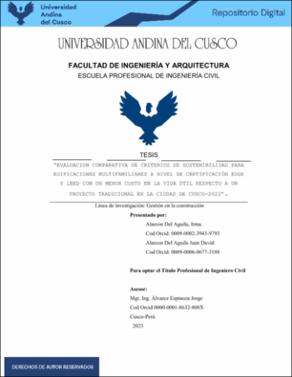| dc.contributor.advisor | Álvarez Espinoza, Jorge | |
| dc.contributor.author | Alarcón Del Aguila, Irma | |
| dc.contributor.author | Alarcon Del Aguila, Juan David | |
| dc.date.accessioned | 2023-12-28T19:44:50Z | |
| dc.date.available | 2023-12-28T19:44:50Z | |
| dc.date.issued | 2023-10-20 | |
| dc.identifier.uri | https://hdl.handle.net/20.500.12557/6005 | |
| dc.description.abstract | La presente tesis titulada: “EVALUACIÓN COMPARATIVA DE CRITERIOS DE
SOSTENIBILIDAD PARA EDIFICACIONES MULTIFAMILIARES A NIVEL DE
CERTIFICACIÓN EDGE Y LEED CON UN MENOR COSTO EN LA VIDA ÚTIL
RESPECTO A UN PROYECTO TRADICIONAL EN LA CIUDAD DE CUSCO-2022”.
Evaluó que en la gran mayoría de edificaciones en nuestra zona de estudio no se tomó en cuenta
los diferentes criterios de sostenibilidad que son de gran importancia para poder llegar a cumplir
los obejtivos de la ONU para el 2030, tomando representativamente un edificio multifamiliar
tradicional ubicado en la AV. De la cultura N°2120, se realizó una comparación presupuestal a
partir de diferentes modificaciones a nivel de mantenimiento y modificaiones en partidas
especificas, tomando como parametros los criterios de Sostenibilidad tanto EDGE como LEED,
de tal modo que se pudo verificar cual de las 2 metodologías se ajusta más a nuestra realidad
social y cual es más factible economicamente de realizar a partir de la comparación presupuestal
así como los gastos que llevaría implementarlas y que beneficios traerían en un futuro respecto
al costo de los elementos basicos que se generan en las viviendas tales como consumo de agua,
consumo de energía eléctrica y las modificaciones tomando en cuenta el mantenimiento futuro.
Posteriormente después de desarrollado el trabajo se concluyó que la certificación más
adecuada de acuerdo a nuestro contexto social y econcomico es la certificacion EDGE, debido
a que gracias a la comparación de costos y presupuestos Esta supera a la certificación LEED en
un 25.02% y en un 92.74% a una vivienda multifamiliar tradicional, en los años de retorno
económico correspondiente.
A partir de los programas se hace una linea de tendencia con los datos y se ven los posibles
ahorros en cuanto al consumo electrico y de agua potable dando como resultado que
tradicionalmente en promedio se tiene un consumo de 8.30𝑚
en agua mensualmente por
departamernto y en energía de 92.00 kw.h mensualmente por departamento. En tanto si se
harían las correspondientes implementaciones de acuerdo a la certificación EDGE Y LEED el
ahorro se manifestaría en un 9.22𝑚
en consumo de agua mensual por departamento y en un
33.4kw.h en consumo de energia mensual por departamento. | es_PE |
| dc.description.abstract | This research was entitled: "COMPARATIVE EVALUATION OF SUSTAINABILITY
CRITERIA FOR MULTI-FAMILY BUILDINGS AT THE EDGE AND LEED
CERTIFICATION LEVEL WITH A LOWER COST IN USEFUL LIFE COMPARED TO A
TRADITIONAL PROJECT IN THE CITY OF CUSCO-2022". Assessed that in the vast
majority of buildings in our study area, the different sustainability criteria were not taken into
account, which are of great importance in order to meet the UN objectives for 2030,
representatively taking a traditional multi-family building located in the AV. Of culture No.
2120, a budget comparison was made based on different modifications at the maintenance level
and modifications in specific items, taking as parameters the criteria of Sustainability both
EDGE and LEED, in such a way that it was possible to verify which of the 2 methodologies is
more adjusted to our social reality and which is more economically feasible to carry out from
the budget comparison as well as the expenses that it would take to implement them and what
benefits they would bring in the future with respect to the cost of the basic elements that are
generated in the houses such as water consumption, electrical energy consumption and
modifications taking into account future maintenance.
Later, after developing the work, it was concluded that the most appropriate certification
according to our social and economic context is the EDGE certification, because thanks to the
comparison of costs and budgets, it exceeds the LEED certification by 25.02% and by 92.74%
to a traditional multifamily home, in the years of corresponding economic return.
From the programs, a trend line is made with the data and the possible savings are seen in terms
of electricity consumption and drinking water, resulting in a traditional average consumption
of 8.30m^3 of water monthly per department. and in energy of 92.00 kw.h monthly per
department. Meanwhile, if the corresponding implementations were made according to the
EDGE and LEED certification, the savings would manifest in 9.22m^3 in monthly water
consumption per department and 33.4kw.h in monthly energy consumption per department. | en_US |
| dc.format | application/pdf | es_PE |
| dc.language.iso | spa | es_PE |
| dc.publisher | Universidad Andina del Cusco | es_PE |
| dc.rights | info:eu-repo/semantics/openAccess | es_PE |
| dc.rights.uri | https://creativecommons.org/licenses/by-nc-nd/4.0/ | es_PE |
| dc.subject | Certificación | es_PE |
| dc.subject | Consumo de agua | es_PE |
| dc.subject | Costos y presupuestos | es_PE |
| dc.title | Evaluación comparativa de criterios de sostenibilidad para edificaciones multifamiliares a nivel de certificación Edge y leed con un menor costo en la vida útil respecto a un proyecto tradicional en la ciudad de Cusco-2022 | es_PE |
| dc.type | info:eu-repo/semantics/bachelorThesis | es_PE |
| thesis.degree.name | Ingeniero Civil | es_PE |
| thesis.degree.grantor | Universidad Andina del Cusco. Facultad de Ingeniería y Arquitectura | es_PE |
| thesis.degree.discipline | Ingeniería Civil | es_PE |
| dc.publisher.country | PE | es_PE |
| dc.subject.ocde | https://purl.org/pe-repo/ocde/ford#2.01.01 | es_PE |
| renati.advisor.dni | 23818765 | |
| renati.advisor.orcid | https://orcid.org/0000-0001-8632-808X | es_PE |
| renati.author.dni | 71421516 | |
| renati.author.dni | 71421980 | |
| renati.discipline | 732016 | es_PE |
| renati.juror | Cana Paullo, Hugo | |
| renati.juror | Alvarez Alvarez, Goyo | |
| renati.juror | Arenas Lazarte, Javier | |
| renati.juror | Ascue Escalante, Kildare Jussety | |
| renati.level | https://purl.org/pe-repo/renati/level#tituloProfesional | es_PE |
| renati.type | https://purl.org/pe-repo/renati/type#tesis | es_PE |




